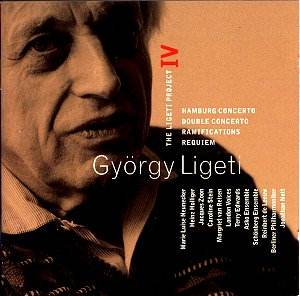This is, we are told, the penultimate release
in the Ligeti Project, a series that Teldec took over from Sony.
It aims to put on disc all Ligeti’s major works, performed by
some of the world’s leading musicians and in state-of-the-art
sound, a sort of ‘definitive edition’ for generations to come.
This new disc is every bit as good as its predecessors, and follows
their enterprising programming, where we get classics from his
early career put alongside the very latest from his pen. The resulting
juxtaposition is one of the most interesting things about the
series.
The work that opens this new record is the Horn
Concerto, subtitled The Hamburg Concerto.
Though composed in 1998, it was revised as recently as last year.
It is a work of great variety and contrast, and shows complete
mastery of form and instrumental texture. The piece is laid out
in the sort of arch shape so beloved of Bartok, where the seven
individual movements have a mirror symmetry – the first and seventh
movements correspond, as do two and six and three and five, leaving
the fourth as the longest, emotional heart of the work. It opens
as we might expect, with ghostly clusters for the featured soloist
and the four natural horns that serve as its partners. Ligeti
is able to play the timbral qualities of the instruments off against
one another, exploiting the dissonance and complex beat patterns
that ensue. The following movements show us his interest in dance
rhythms (the second is subtitled Signale, Tanz, Choral)
and the marvellous Intermezzo that is the fourth movement has
the greatest variety of all, displaying Marie Luise Neunecker’s
stunning virtuosity into the bargain. The episode at 2’50 shows
influence of African polyrhythms, with soloist and orchestra conjuring
up a heady mix of birdsong and wild chanting. The closing Hymnus
echoes the haunting opening Praeludium, and the whole work is
a great example of what a composer in complete command of his
musical language can do in a mere 15 minutes.
The remaining items on the disc are all established
favourites in the Ligeti canon. Ramifications is
nowhere near as daunting as the composer’s rather dry booklet
description would lead you to believe. It is a piece where atmosphere
is all important, and it reminded me more than once of a neo-Bartókian
nachtmusik movement, where the rustlings and flutterings
of the night are vividly brought to life by the 12 solo strings.
This 8-minute nocturnal soundscape is as resourceful as anything
in Ligeti’s output.
The same might be said of the quirkily inventive
Double Concerto, which I remember as a highlight
of the Huddersfield Contemporary Music Festival a few years ago,
when Ligeti was the featured composer and guest of honour. Its
two movements form a contrasting duo, marked calm, with tenderness
and fast, like a courante. This piece once again exemplifies
the composer’s concern with alternations of harmonically dissonant
stillness and witty, vivacious dance patterns. The performance
is exceptional.
The famous Requiem, put to sensational
(if unacknowledged) use by Stanley Kubrick in 2001:A Space
Odyssey, is a ‘live’ Berlin performance conducted by our own
Ligeti expert Jonathan Nott, who seems to work permanently abroad
these days. He coaxes singing and playing of great beauty and
phenomenal accuracy. This piece put the composer on the map, and
is still the best example of his early sound world. Its cosmic
clouds of quarter-tone harmony and almost hysterical choral textures
are still difficult to bring off well, and the Terry Edwards-trained
London Voices acquit themselves with great aplomb. There are rivals
in the catalogue, but you will never hear it performed better
than this.
Booklet notes are by the composer, and are certainly
authoritative and illuminating, if a little analytical. A special
word of praise must go to the recording. The Teldec producers
have worked miracles in capturing these difficult textures in
such a superb way, a real model of perfectly judged aural engineering.
All in all, a highly recommended continuance of this valuable
series.
Tony Haywood
Also see: Volume
1; Volume
2; Volume
3
